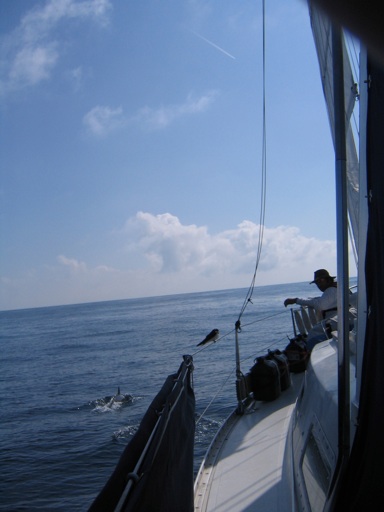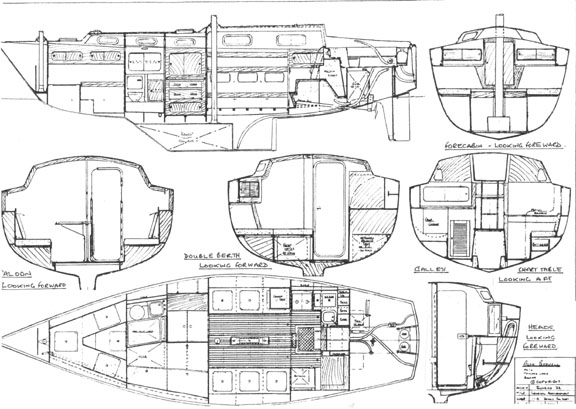
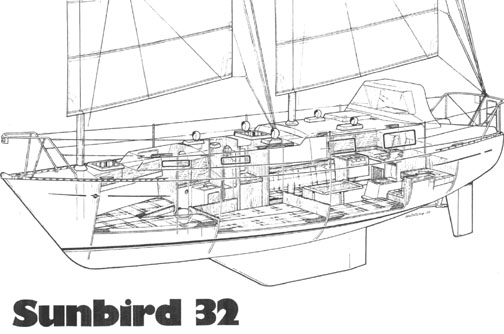
Below decks, this class of boat
is very spacious. There is standing headroom through from
front to back, and the offset design of the master bunk makes
for a comfortable double berth. (There are lee cloths and
fixing points on all the berths though, so the main berth
mattress is split to allow you to secure yourself if need be.)
There are lockers everywhere. We have taken over some of them
for tankage, but even so, there is masses of room. The main
cabin table will let you lay out a full Admiralty chart, or do
some serious sewing. Our 14 foot sail covers were sewn in the
cabin.
Kiao Fang is lovely to live on. She is stable, roomy, and moves well in the water. She sails beautifully, and motors economically (less than a litre and a half of fuel an hour). There is enough room below not to be tripping over each other, and copious storage for clothing, food, drink, spares and all the tools and gadgets which accumulate when you are living aboard. We have been very comfortable on her both at sea and moored. Little touches in the design help, like crockery cupboard over the galley sink with built in drainer, and the way in which you can sit braced at the stove, and the ability to mount lookout from the gangway steps without venturing into the cockpit.
Kiao Fang is lovely to live on. She is stable, roomy, and moves well in the water. She sails beautifully, and motors economically (less than a litre and a half of fuel an hour). There is enough room below not to be tripping over each other, and copious storage for clothing, food, drink, spares and all the tools and gadgets which accumulate when you are living aboard. We have been very comfortable on her both at sea and moored. Little touches in the design help, like crockery cupboard over the galley sink with built in drainer, and the way in which you can sit braced at the stove, and the ability to mount lookout from the gangway steps without venturing into the cockpit.
Safety is an important factor
for us. Apart from the obvious advantages due to the rig
itself, Kiao Fang is a safe boat. You can get out from the
main hatch, the mid hatch and the fore hatch. The cockpit on
the production boat felt secure, and is even more so now on
Kiao Fang. She is not tender, being well ballasted. The keel
is encapsulated - one with the hull as a whole - so no keel
bolts to rust and fail. She was built in the seventies when
fibreglass construction was much more heavyweight than now.
Kiao Fang no longer looks quite
like the drawings above. We have toughened her where
experience showed she needed it; we have added modern
equipment for safety, navigability and comfort; and we have
tried to lower the maintenance costs in such areas as
antifouling. Here is how she looks now.
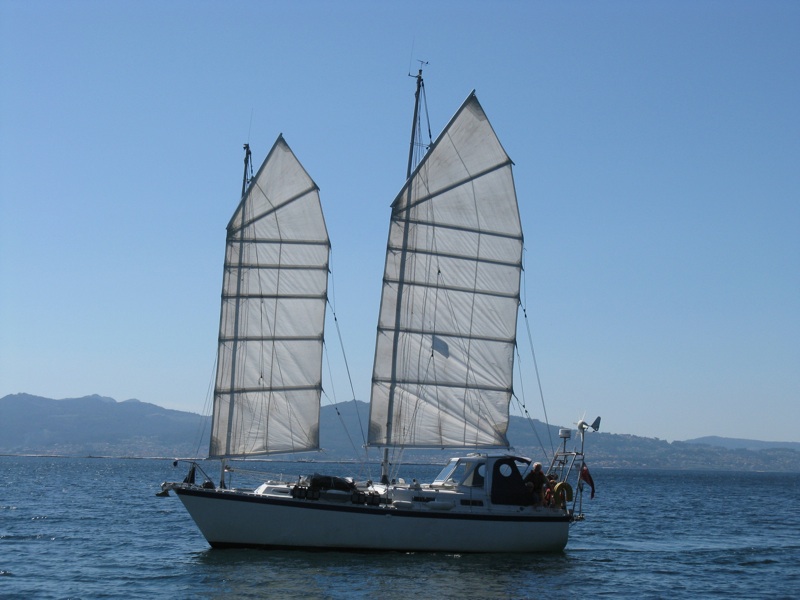
The most obvious changes are to
the cockpit. The doghouse offers a lot of protection and gives
us somewhere to house the large solar panels. It is designed
as a lightweight structure: think more 'stiff sprayhood' than
Fisher - style integral heavyweight. The construction is
marine ply over mahogany frames, with stainless steel
reinforcement for the laminated roof supports. There are
removable canvas side panels and a canvas roof extension.
Together with the stern superstructure, it's easy to rig
cockpit sunshades for a shady corner when moored. The front
window opens wide (and two screws remove it completely if you
want a through breeze in a hot marina).
The superstructure at the stern
does several jobs. It houses the radar, solar panel, emergency
antenna mount and the wind generator. It also ties in with the
pushpit, adding stiffness where it is needed - the pushpit
doubles as the sheet mount point. We reinforced that, too.
This is what it looked like while we were working on her in
Glasson Dock, her previous home port.
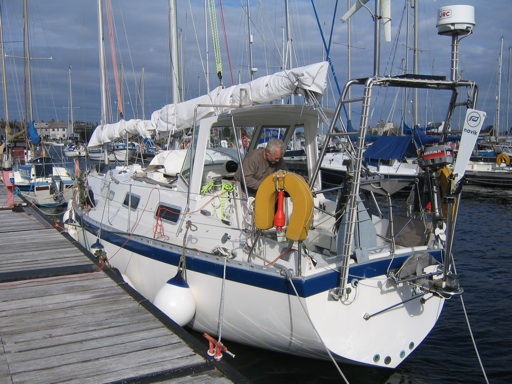
The Navic self steering in
the picture was installed at this stage, but only after we
had added extra stiffening to the transom. You can see the
stowage for the Kedge / spare main anchor.
At the stem, we replaced
the old ground tackle gear and installed a new winch,
large cleat, and twin swivelling bow rollers. As with the
transom, we added a lot of strength to this area of the
boat by rebuilding the deck partner and adding a very
substantial plate below the forepeak.
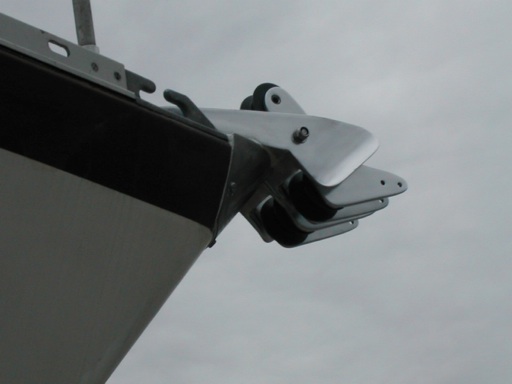
Less obvious are the
changes to the sails and rigging. The main improvement was
in battens and booms - we changed the wooden, stiff and
heavy set for extruded fibreglass components designed to
allow the sails to take a curve when going to windward.
Each batten is a different size and flexibility, depending
on how high in the rig it is. The whole sail bundles are
now lighter, and the battens work well.
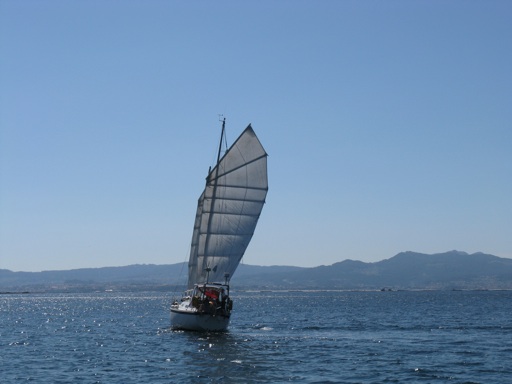
Below, Kiao Fang looks
like this:
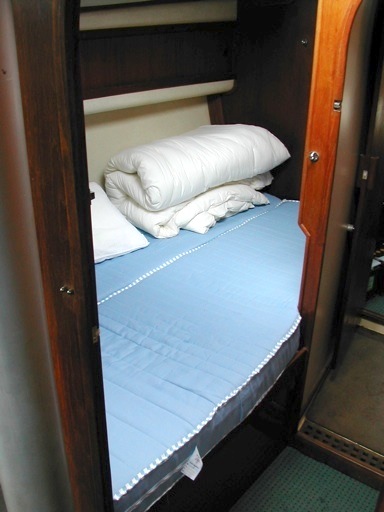
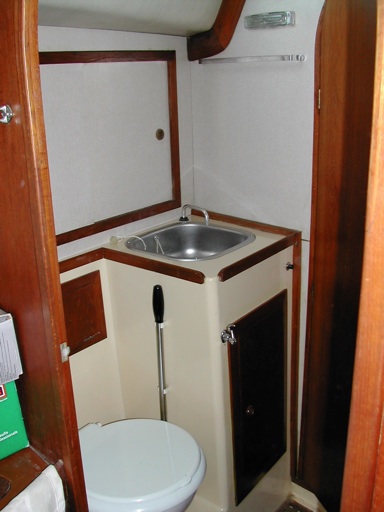
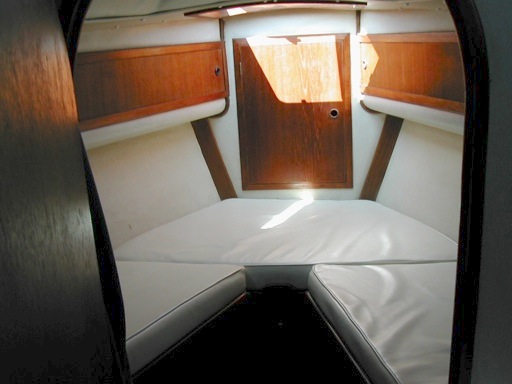
The
navigation station
We concluded that if you are
cruising from a remote base. you don't want to spend time on
avoidable chores. Antifouling is the worst of these, so we
have set up Kiao Fang to avoid it. This season we have
copper-coated her - 6 coats of epoxy and 8 kg of coppercoat on
top of that. So now and for the next ten years the work
consists of drying her out, power-hosing down, cleaning the
prop and shaft and getting her back in the water. The keel
shoe and yacht legs offer some freedom from haul-out and
boatyard fees. The shots below give an impression of the hull,
prop, rope-cutter, keel form and keel shoe. (As with most of
the pictures, they were taken at different times as work
allowed. The shoe was fitted in Glasson during the early
refit, the legs are on display as she is tucked up for winter
in Povoa a couple of winters ago, and the coppering is the
most recent.)
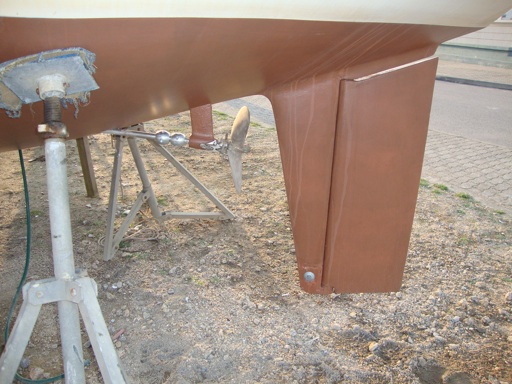
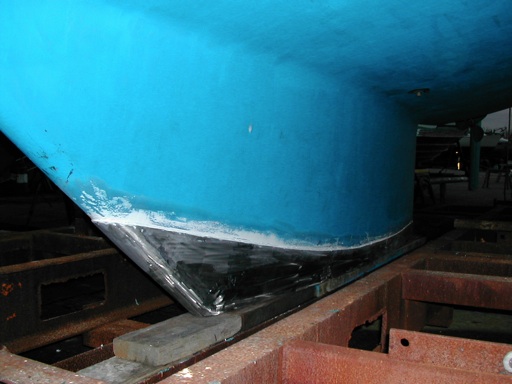
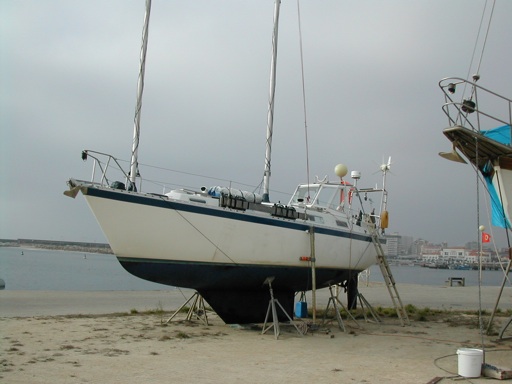
We aim to maintain Kiao Fang as
well as we can: here is a brief outline of what we have done
(so you don't have to). Some of this work is on show in the
Photo Gallery.
- The main hatches have been reglazed in 12mm polycarbonate. The forepeak has been redesigned so as to separate the chain stowage from the base of the foremast, and drainage to starboard incorporated. The drain is well above sea level, but has a lever sea cock for security. This was in part to keep the boat drier, and in part to protect the foremast and step from corrosion. The foremast has been rebuilt and strengthened.
- All seacocks have been replaced and inlet and toilet hoses renewed and sited higher to avoid siphoning.
- All seacocks and outlet ports (above and below waterline) were been fitted with double stainless steel clips.
- We added two further anchors to her inventory. In addition to the 35lb CQR acting as main, a second Danforth and a 25lb fisherman are aboard. As well as the 50m 9/16 main anchor chain, 30 metres of supplementary 3/8 chain is also carried, together with 100 metres of anchorplait. These are provided with appropriate shackles enabling them to be used with any chosen ground tackle. An anchor chain lock is provided on deck, and a substantial cleat has been added.
- A fuel cut-off valve was fitted outwith the engine compartment: access is now from the cockpit area. We replaced the fuel lines; primary fuel filter and water trap, and removed, checked, and doubly secured the fuel tank, adding external air vents.
- The engine exhaust hose was replaced.
- We stepped both masts and replaced their fittings and electrics; the foremast was strengthened as a precautionary measure; mast steps removed, rebuilt with much thicker material and refitted, and mast partners checked and reinforced. Both masts were provided with emergency halyard blocks before re-stepping.
- All running rigging has been replaced. There is no stainless standing rigging, but the safety rails have been replaced, along with worn stanchions.
- Broken fairleads have been removed, substructure reinforced, and new fairleads fitted. Substantial new internal load spreader pads have been added to these and other deck fittings.
- Kiao Fang’s limited instrumentation was improved by addition of a Radar; Navtex; DSC VHF radio; multiple VHF antenna options; Log and Depth (relocating original Depth instrument to cockpit); and by linking the GPS into a PC for mapping.
- The rudder has been removed, drained and reinforced. New Delrin bearings have been turned and fitted. The tiller has been removed and checked, and reinforced around the area of the hinged joint.
- We added extra cleats at the stern, making four a side.
They came in handy for Irish Sea wall lines, but we found
that they also really help on tiny continental finger
pontoons.
- The original water tank obscured the view of the main bilge, making bilge pump and switch siting and bilge and strum box inspection and maintenance impossible. The tank has been removed and replaced by a three-tank polypropylene system which reveals the bilge, distributes the weight, and allows for partial failure without loss of all water. All electric and manual fresh water pumps and hoses have been replaced.
- The original tank was also too large for the space, so the cabin sole joists had been checked out to accommodate it, thus weakening the structure. We replaced and strengthened the joists with new pitch pine members, and fitted cross supports to stiffen the structure further.
- Bilge pumps - The manual pump has been refurbished, and the main electrical pump relocated into its correct location in the deepest bilge adding a new automatic switch.
- The prop and shaft have been removed, and the shaft has been replaced, with an improved anode system. At the same time, the Volvo stern gland was replaced, and a rope cutter fitted.
- The 12V electrical panel wiring and the mechanical engine control cabling were both exposed to their rear within the cockpit locker: Both have been fitted with protective covers. The main electrical panel has been redesigned to allow rapid access to rear fuses and connections from within the cabin.
- In addition, the electrical cabling to the main distribution panels and within the battery compartment has been rewired, and improved fusing and isolation added. Similarly, the engine, engine controls, and instrumentation cabling has been reworked and secured.
- All pipe runs are now clipped or clamped where they once floated.
- Our preference is not to have gas aboard: we believe there are less risky options. The gas installation has been removed, and a new Taylor Kerosene stove and heater fitted. The onetime gas locker in the cockpit can now safely stow other volatiles. At the same time, a secured and properly vented, commercial poly fuel tank was installed next to the main fuel tank to hold Kerosene prior to hand- transfer into the Taylor pressurised tank.
- Fire safety equipment has been improved. There are automatic powder extinguishers in the engine compartment, and over the Taylor pressure tank; hand extinguishers in each cabin; and a fire blanket near the galley.
- A carbon monoxide monitor has been fitted amidships.
- General safety equipment has been upgraded. Kiao Fang carries a four-person liferaft, Danbuoy, two horseshoes and lights, and a throwing line within reach from the cockpit. Flares have been kept up to date. Harnesses and lifejackets (for four crew) are carried. The first aid kit has been brought up to date. The radar reflector has been replaced. She also now carries an inflatable dinghy with a small outboard.
- Navigation lighting has been refurbished. We can now choose between masthead or deck, and carry battery backups.
- Deck mushroom vents have been replaced where crazed or seized.
The last thing we did on your
behalf was to deliver her across the Bay of Biscay, ready for
your takeoff.
